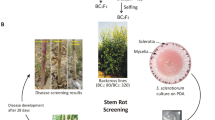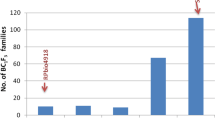Abstract
The Japanese bunching onion, Allium fistulosum L., is an important vegetable in East Asia. However, the stone leek leafminer, Liriomyza chinensis (Kato), is a serious insect pest that invades the Allium species. As the feeding punctures on the leaf surface caused by the female adults as well as the larval mining inside the unifacial leaves reduce the commercial value of A. fistulosum, it is essential to control L. chinensis during its growth. The accession ‘Beicong’ has shown resistance to L. chinensis due to its egg-killing defense, but the degree of resistance varies within the ‘Beicong’ population. Therefore, in the present study, we selected highly resistant selfed lines from the ‘Beicong’ population by artificially inoculating L. chinensis eggs into the leaves to breed A. fistulosum with a resistance to L. chinensis. A highly resistant line was obtained by continuously self-pollinating the resistant ‘Beicong’ individual among the 191 individuals, which was inherited in the F1 hybrid of the resistant line and the susceptible variety. However, the F1 hybrid’s degree of resistance was an intermediate of the two parents’. It was also revealed that the resistance of ‘Beicong’ was due to both egg- and larval-killing defense mechanisms by artificially inoculating the eggs and larvae into the leaves. Hence, developing a highly resistant line could contribute to integrated pest management in A. fistulosum cultivation by decreasing the population of L. chinensis.



Similar content being viewed by others
Data availability
Not applicable.
Code availability
Not applicable.
References
Chen XJ, Lang F, Xu Z, Jun-hua HE, Ma Y (2003) The occurrence of leafminers and their parasitoids on vegetables and weeds in Hangzhou area, Southeast China. Biocontrol 48:515–527. https://doi.org/10.1023/A:1025726813462
Choi IH, Kim JW, Kim GH, Kim CW (2003) Injury aspects of the stone leek leafminer, Liriomyza chinensis Kato (Diptera: Agromyzidae) on Welsh onion. Korean J Appl Entomol 42:335–343 (in Korean with English abstract)
De Jong J, Rademaker W (1991) Life history studies of the leaf miner Liriomyza trifolii on susceptible and resistent cultivars of Dendranthema grandiflori. Euphytica 56:47–53. https://doi.org/10.1007/BF00041743
Ford-Lloyd BV, Armstrong SJ (1993) Welsh onion Allium fistulosum L. In: G. and Bergh BO (eds) “Genetic Improvement of Vegetable Crops” Kalloo. Pergamon Press, London, pp 51–58
Japan Metrological Agency (2020) Seasonal mean temperature in Japan. Available from https://www.data.jma.go.jp/cpdinfo/temp (Accessed 15 November 2020) (in Japanese)
Kai S, Morita S (2001) Control by solar radiation against Liriomyza chinensis (Kato) on Welsh onion in the green house. Kyushu Pl Prot Res 47:108–111 (in Japanese)
Kumazawa S, Katsumata H (1965) Negi (Japanese bunching onion). In: “Sosai-engei kakuron (Vegetable crops)” Kumazawa. S. (ed.), Yokendo press, Tokyo, pp 280–289 (in Japanese)
Martinez M (1982) Contribution a l’etude des Agromyzidae de France (Dipt.). Liriomyza nietzkei Spencer et Liriomyza chinensis (Kato), deux especes d’importance economique presentes en France. Bulletin de la Societe entomologique de France 87:302–308 (in French)
Martynov VV, Nikulina TV, Gubin AI (2016) Range expansion of invasive stone leek leafminer Liriomyza chinensis (Kato, 1949) (Diptera: Agromyzidae) in Eastern Europe. Euroasian Entomol J 15:420–421
Oida H, Kawana T (2017) Hymenopterous parasitoids of Agromyzid leafminers (Diptera: Agromyzidae) on leaves and flowers of Phacelia tanacetifolia in Chiba Pref., Japan and potential of P. tanacetifolia as a banker plant or insectary plant to control Liriomyza chinensis (Diptera: Agromyzidae). Jpn J Appl Entomol Zool 61:233–241. https://doi.org/10.1303/jjaez.2017.233(in Japanese with English abstract)
Papp L, Cerny M (2017) Agromyzidae (Diptera) of Hungary, vol 3. Pars Ltd, Nagykovácsi
SAS Institute (2020) JMP, version 13.2.1. SAS Institute, Cary
Scheffer SJ (2000) Molecular evidence of cryptic species within the Liriomyza huidobrensis (Diptera: Agromyzidae). J Econ Entomol 93:1146–1151. https://doi.org/10.1603/0022-0493-93.4.1146
Schrameyer K (2001) Mining pests of Allium vegetable species. Gemüse (München) 37:17–20 (in German with English abstract)
Sueyoshi T, Shimomura K, Koga T, Yamamura Y, Takemoto H (2006) The varietal difference in resistance to stone leek leafminer in Welsh onions. Bull Fukuoka Agric Res Cent 25:37–41 (in Japanese with English abstract)
Takeda M, Kawai A, Mitsunaga T, Tsukazaki H, Yamashita K, Wako T (2020) A novel method for evaluating the egg killing defenses and varietal resistance of the bunching onion against Liriomyza chinensis (Diptera: Agromyzidae) via the artificial inoculation of eggs. Appl Entomol Zool 55:93–103. https://doi.org/10.1007/s13355-019-00657-7
Tokumaru S (2016) Effects of temperature and photoperiod on development and reproductive potential of Liriomyza chinensis (Diptera: Agromyzidae). Jpn J Appl Entomol Zool 60:189–196. https://doi.org/10.1303/jjaez.2016.189(in Japanese with English abstract)
Tokumaru S, Uesugi R (2019) Occurrence of genotype of Liriomyza chinensis Kato in Kyoto Prefecture. Shokubutsu-boueki. (Plant Protection) 73:581–583 (in Japanese)
Tran DH, Takagi M (2005) Developmental biology of Liriomyza chinensis (Diptera: Agromyzidae) on onion. J Facul Agric Kyushu Univ 50:375–382
Urairi C, Kawai A, Takeda M (2020) A method for mass-rearing Liriomyza chinensis (Diptera: Agromyzidae) Appl Entomol Zool 55:423–428. https://doi.org/10.1007/s13355-020-00697-4
Acknowledgements
We thank Ms. K. Nomura, Ms. K. Tanaka, Ms. M. Okamoto, Mr. M. Kitazumi, Mr. Y. Honda, Mr. T. Izumi, and Mr. T. Momiyama for breeding the plant material. We also thank Dr. T. Yamada for the useful discussions.
Funding
No funds, grants, or other support was received.
Author information
Authors and Affiliations
Contributions
Conceptualization, S. F., K. Y., T. W., and M. T.; Methodology, S. F., K. Y., T. W., and M. T.; Investigation, S. F., C. U., K. Y., and A. K.; Writing-Original Draft, S. F.; Writing-Review and Editing, S. F., C. U., K. Y., T. W., A. K., and M. T.
Corresponding author
Ethics declarations
Conflicts of interest
The authors declare that they have no competing interests.
Additional information
Publisher’s note
Springer Nature remains neutral with regard to jurisdictional claims in published maps and institutional affiliations.
Rights and permissions
About this article
Cite this article
Fujito, S., Urairi, C., Yamashita, Ki. et al. Japanese bunching onion line with a high resistance to the stone leek leafminer, Liriomyza chinensis from the ‘Beicong’ population: evaluating the inheritance of resistance. Euphytica 217, 31 (2021). https://doi.org/10.1007/s10681-020-02764-x
Received:
Accepted:
Published:
DOI: https://doi.org/10.1007/s10681-020-02764-x




